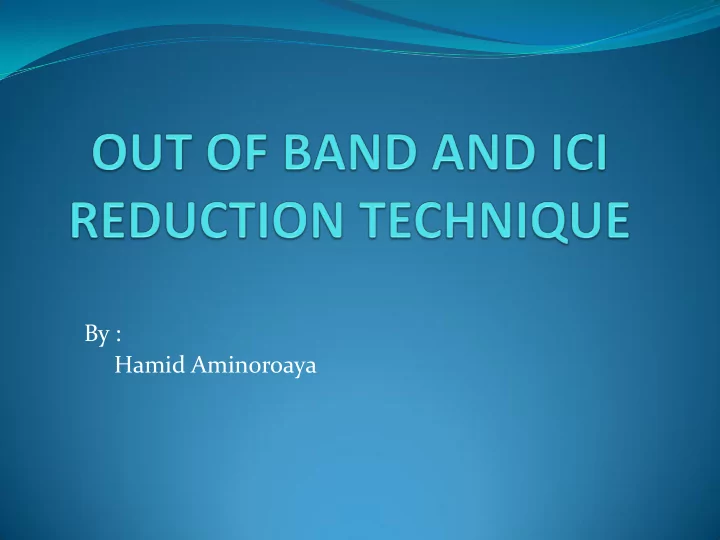

By : Hamid Aminoroaya
There is a substantial need for more frequency bandwidth and the efficient and flexible use of existing bands. Cognitive Radio Multi-carrier modulation OFDM (orthogonal frequency division modulation) Out-of-band (OOB) radiation -- Inter-carrier-interference (ICI) Peak-to-average power ratio (PAPR) 2/25
OFDM system 3/25
Out of band (OOB) component S(x ) = dn · sinc ( x − xn ) , x = ( f − f 0 ) T 0 The sidelobe power of this sum signal only decays with 1 / ( x 2 N ) resulting in a high out-of-band radiation. 4/25
OOB reduction technique Windowing Guard band Cancellation Carrier (CC) Subcarrier Weighting (SW) Multiple Choice Sequences (MCS) Constellation Expansion (CE) Additive Signal Method (AS) Combined methods 5/25
Windowing The signal r(k) is windowed in the time domain by a window function w(k) : r ˆ (k) = r(k) w(k) making the PDS of an OFDM modulated carrier go down more rapidly by windowing the transmit signal of the OFDM symbols. A commonly used window type is the raised cosine window. drawback of this method is that windowing expands the signal in time domain and intersymbol interference (ISI) is introduced. 6/25
Windowing Even at very high rolloff factors, the achievable interference reduction is only about 6dB. n = number of adjacent sub-band 7/25
Guard band The drawback of this method is the less effective use of the available bandwidth. 8/25
Guard band b = number of deactivated adjacent subcarriers deactivation of the first adjacent subcarrier ( b = 1) delivers the largest benefit. The additional deactivation of more subcarriers ( b ≥ 2 ) only provides a minor further improvement. 9/25
Cancellation Carrier (CC) Each CC is multiplied by a complex weighting factor gm the transmit symbol is modulated on N + M subcarriers 10/25
Cancellation Carrier (CC) The constraint limits the power of the CCs to α in order not to spend too much Tx power on the CCs. with only two CCs at each side of the used spectrum the out-of-band radiation can be reduced by more than 20 dB. The price is Loss in BER performance Increased computational complexity. 11/25
Subcarrier Weighting (SW) multiplication of each symbol dn with a real valued weighting factor gn . Pulse shaping 12/25
Subcarrier Weighting (SW) solving the optimization problem with two constraints: Keeps the transmission power the same as in the case without weighting i.e. ||¯ d || 2 = || d || 2 . elements of g are between pre-defined limits, i.e., g min ≤ gn ≤ g max ρ = gmax/gmin bit-error rate (BER) OOB 13/25
Multiple Choice Sequences (MCS) The principle is to map original transmission sequence into another transmission sequence, which has lower sidelobes. algorithms to generate an MCS set : Symbol constellation approach Interleaving approach Phase approach 14/25
Constellation Expansion (CE) Exploiting the fact that different sequences have different sidelobe power levels the symbols that modulates k bits/symbol (2 k constellation points) are mapped to a modulation scheme that modulates ( k +1) bits/symbol and consisting of 2 k +1 constellation points. 15/25
Additive Signal Method (AS) optimization problem with two constraints: Transmission power the same as in the original sequence elements of a are between pre-defined limits , i.e.,|| an|| ≤ R There is a trade-off between the additional sidelobe suppression obtained by enlarging the radius R and the increased loss in SNR performance. 16/25
Combined methods CC + CE CC + windowing MCS + CC MCS + SW SW + guard band 17/25
Inter carrier interference (ICI) OFDM is very sensitive to frequency errors, caused by : Carrier frequency mismatch between the transmitter and receiver The Doppler shift. Leads to an orthogonality-loss between carriers and intercarrier interference (ICI) will occur. 18/25
Inter carrier interference (ICI) Received signal After FFT carrier-to-interference power ratio (CIR) 19/25
ICI reduction methods ICI self-cancellation pulse shaping select mapping frequency-domain equalization time-domain windowing 20/25
ICI self-cancellation the difference between S(l-k) and S(l-k+1) is very small. If a data pair is modulated onto two adjacent subcarriers (a,-a), then the ICI signals generated by the subcarriers will cancel themselves. 21/25
ICI self-cancellation ICI self-cancellation scheme can also be extended to group of L subcarriers. 22/25
pulse shaping Rectangular pulse (REC) Raised cosine pulse (RC) Better than raised cosine pulse (BTRC) Sinc power pulse (SP) Improved sinc power pulse (ISP) 23/25
pulse shaping 24/25
25/25
Recommend
More recommend